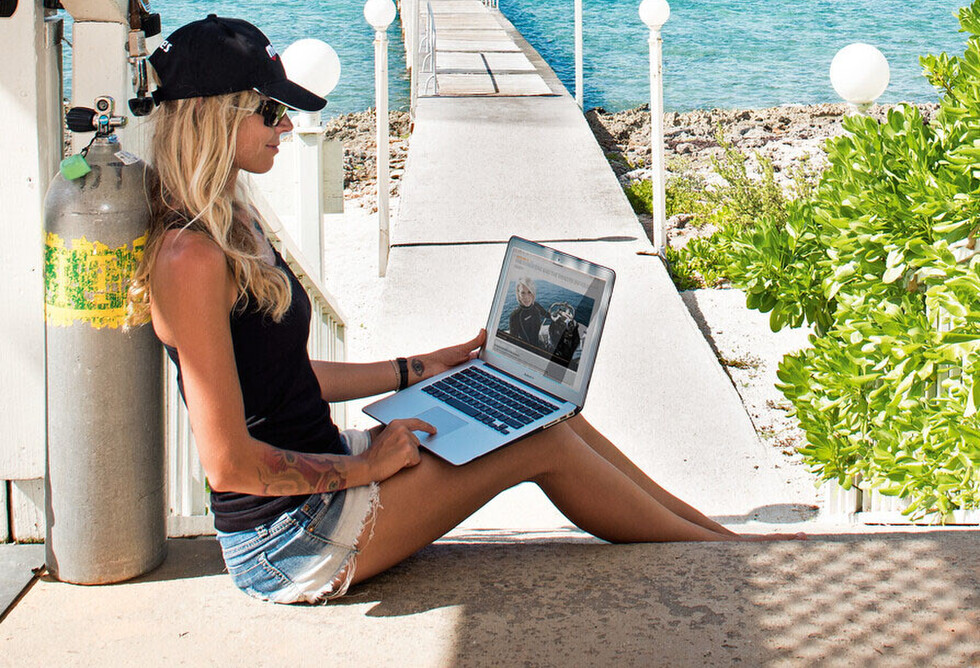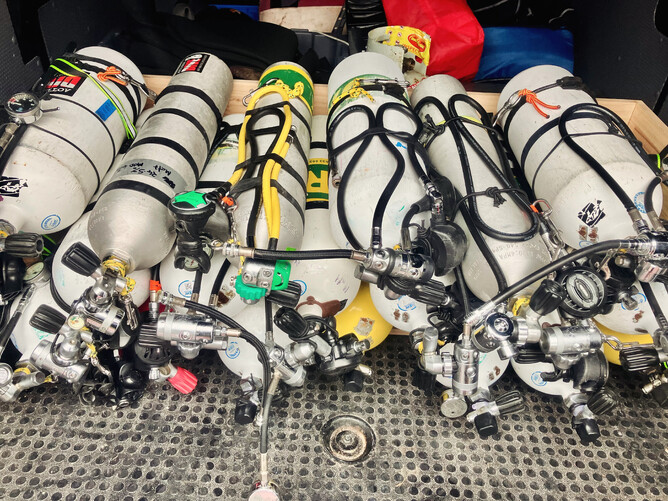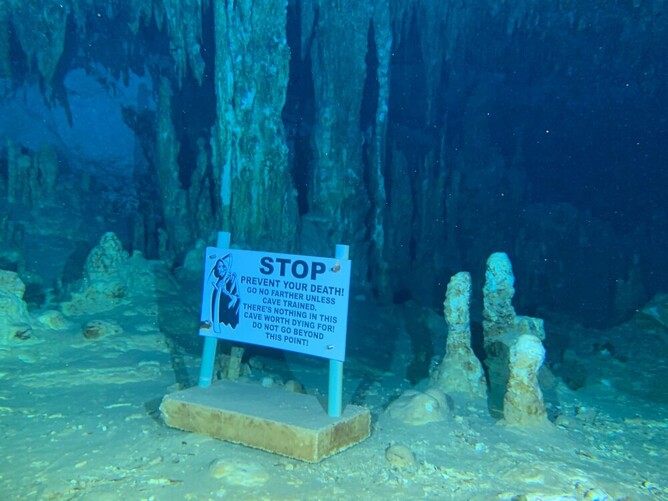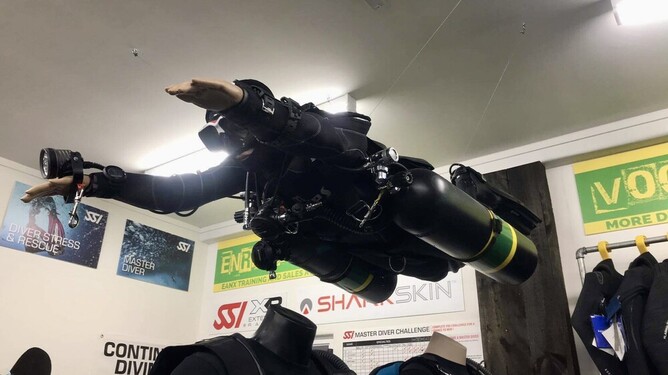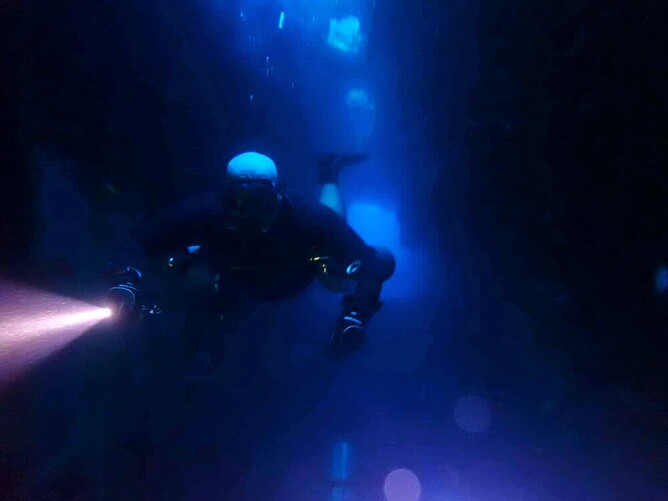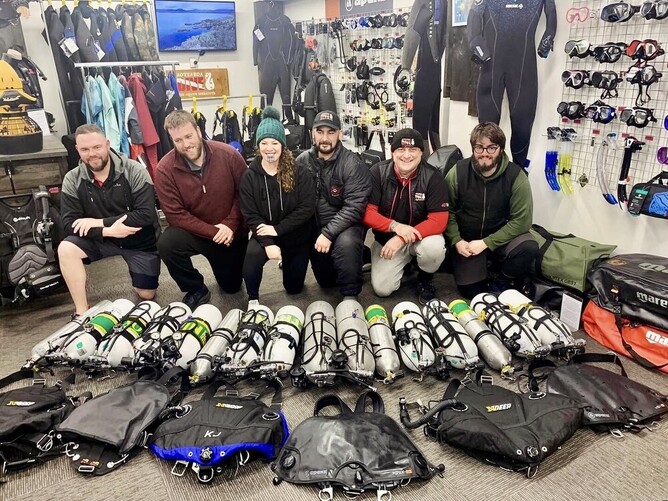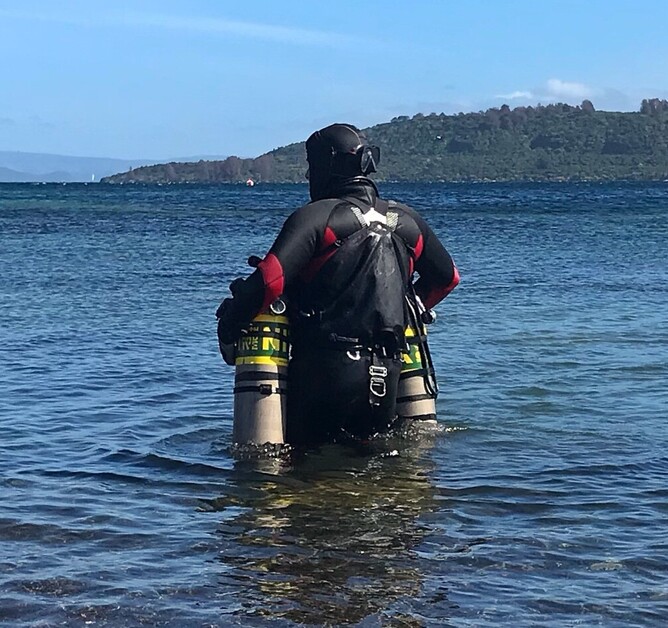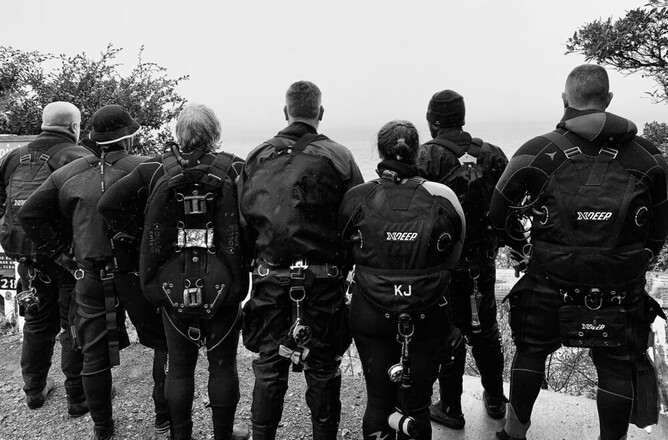Sidemount diving - the where's, why's and how it can elevate your diving
Sidemount looks sleek and modern: two cylinders riding low and tight along the diver’s sides, hoses routed cleanly, a small wing hugging the torso. But the configuration isn’t a fashion statement. It was born of need—narrow restrictions, awkward carry-ins, long penetrations—and it matured because its practical benefits translate to almost every corner of diving, from vacation reefs to expedition caves. This article traces the history of sidemount, explains why it works so well, and offers a grounded look at when (and how) it can make your diving safer, calmer, and more capable.
Origins: Getting Big Gas Through Small Holes
Long before sidemount appeared on glossy training posters, cavers in the UK and speleologists elsewhere were dragging cylinders through sumps—short flooded sections inside dry caves—where backmounted doubles simply wouldn’t fit. Imagine crawling through an ear-sized rock fracture with a steel backplate on your spine: it’s a nonstarter. The workaround was simple and ingenious: remove the cylinder from the back, clip it along the thigh or hip, and push or pull it through. In those early days the “harness” was often a belt with a D-ring, a few boltsnaps, and perseverance.
Across the Atlantic, Florida and Mexican cave divers encountered similar constraints, but with longer swim sections and different geology. Diver-tinkerers began to systematize the approach. They shortened and streamlined hoses, experimented with bungee systems to control cylinder trim, and adapted minimalist buoyancy cells to keep profile and drag low. What began as a haul-it-through-sumps hack hardened into a repeatable configuration: two independent cylinders clipped along the body, valves forward and visible, secondaries parked neatly on bungees, and a wing small enough to avoid snagging in tight spaces.
STOP!
By the early 2000s, dedicated sidemount harnesses and wings were hitting the market. Training agencies that once considered sidemount a niche now offered standardised training programs. Cave teams used it to pass restrictions, wreck explorers used it to snake through collapsed decks, and recreational divers discovered a surprising bonus: sidemount wasn’t only for overhead environments; it could be an elegant way to carry redundant gas and reduce back strain on open water dives.
The Core Design: Independent, Visible, Controllable
At heart, sidemount is less about where the cylinders are and more about how the system behaves. Three design ideas drive the configuration:
1. Independence for redundancy.
Two separate cylinders with two first stages, two second stages, and isolated gas supplies give true redundancy. A failure on one side leaves the other unaffected. Gas management is manual—alternating regulators to maintain balance—but that manuality is a feature: the diver knows, in real time, what’s available.
2. Valves forward and observable.
With valves in the diver’s field of view, diagnosing problems becomes faster and less stressful. A free-flow, a bubbling SPG, or a weeping O-ring can be seen, reached, and addressed accordingly without a buddy’s intervention.
3. Streamlining and trim.
Cylinders lie parallel to the body’s long axis, reducing frontal area and improving balance. Buoyancy is centered around the torso, and weighting is distributed along the spine, making fine-tuned trim easier in any position.
Those principles deliver concrete benefits—safety, comfort, control.
Benefit 1: Real Redundancy Without the Bulk
Backmounted doubles provide redundancy via a manifold. It’s a strong system, but it adds width, weight, and a tall center of mass that can be ungainly on land or on pitching boats. Sidemount splits the gas into two entirely independent systems. That lets a diver tailor the dive to the plan: one cylinder for a shallow reef with an independent bailout; two for deeper or longer profiles; larger or smaller cylinders as conditions dictate. There’s no single “right” cylinder—steel in cold water, aluminum in warm water, or mixed choices to balance buoyancy across the dive. If a regulator free-flows, you close a valve that’s right in front of you, switch to the other side, and continue or abort calmly.
For instructors and dive pros, this is powerful. You can demonstrate problem-solving without theatrics, showing students a clear line of defense: see the issue, isolate, switch, communicate. For recreational divers, the upside is psychological as much as technical: true redundancy reduces anxiety and increases the odds of cool-headed responses.
The shop dummy got it right!
Benefit 2: Comfort and Back Health
Anyone with a sensitive back or a long walk to the water knows the pain of hoisting a single heavy cylinder—or worse, a set of doubles. Sidemount lets you carry cylinders one at a time, clip them in the water, and leave the back free of a tall metal load. On a rocky shore or a long pier, that’s the difference between gritted teeth and a relaxed start.
Underwater, the comfort dividend continues. Weight is lower and more evenly distributed, the wing is small, and there’s no heavy pack bridging shoulders. Trim adjustments happen with subtle finning rather than constant sculling. For photographers, who spend long minutes hovering motionless, the reduction in micro-tension around the shoulders and neck is tangible.
Benefit 3: Access and Profile in Tight Spaces
Sidemount’s low profile unlocks routes that are off-limits to bulky rigs. In overhead environments, a few centimeters can be decisive; being able to move a cylinder forward through a restriction, or to unclip and push one through, is the difference between yes and no. In wrecks, where line traps and jagged edges threaten hoses and manifolds, having everything tucked tight reduces entanglement risk. Even in open water, a narrower profile helps in surge channels, kelp forests, or current-swept swim-throughs where precise control matters.
President Coolidge - Vanuatu - Aotearoa Dive expedition 2025
Benefit 4: Trim, Buoyancy, and Gas Stability
Because cylinders in sidemount lie along the body, changes in buoyancy as gas is used feel different than in backmount. In aluminum cylinders, buoyancy swings are more noticeable, but the bungee-and-clip geometry keeps cylinders pinned and neatly in line, minimizing pitch changes. With steels, the configuration yields a very stable platform that lets you hold flat trim with less effort. Once your harness and bungee lengths are dialed in, you’ll likely find you’re using smaller corrections, smaller breaths, and fewer wing adjustments to hold a stop. That steadiness pays off in better gas consumption and more accurate decompression or safety stops.
Benefit 5: Gas Management and Situational Awareness
Sidemount nudges divers into better habits. Because you alternate second stages to balance pressure between cylinders, you become intentionally aware of consumption. You’ll check SPGs more often—because they’re easy to see on short hoses (or better still utilising transmitters linked directly to your dive computer)—and you’ll learn to anticipate cylinder buoyancy changes. Valves and first stages are visible and reachable; a small leak isn’t a mystery to be inferred—it’s a fact you can see, touch, and quickly correct. The configuration teaches quiet competence: fewer big adjustments, more small observations.
Benefit 6: Flexibility Across Environments
A typical sidemount rig packs easily and travels well: a soft harness, a compact wing, two first stages, and accessories. On holiday, you can rent matching aluminum cylinders at the destination; at home, you can clip on your preferred steels. In cold water with a drysuit, sidemount shines because buoyancy is distributed and the rig doesn’t fight the suit’s bubble. In warm water with a thin wetsuit, the minimalist harness feels almost invisible.
For shore entries, you can clip one cylinder, swim out, then clip the second; for boat dives, you can kit up seated, with crew passing cylinders to you in the water or at the swim platform—safer for your back and kinder on small boats.
Obligatory team shot - XR Sidemount training
What Sidemount Isn’t (and When It’s Not Ideal)
Sidemount isn’t a magic spell, and it’s not always the best tool. If you’re doing deep open-water trimix with long-deco and big gas volumes, backmounted doubles with a stage or two might be simpler for gas sharing and team standardisation. If your local diving is always guided, shallow, and single-tank friendly, the advantages of redundancy may be offset by rental logistics—some operations are unfamiliar with sidemount support.
Sidemount also rewards precise setup. A sloppy harness, mis-sized bungees, or poorly placed D-rings will make cylinders hang like saddlebags and spoil the trim advantages. That’s not a reason to avoid it; it’s a reason to get good training and take the time to dial in the geometry for your body, exposure suit, and cylinder type.
Anatomy of a Well-Tuned Sidemount Rig
A clean rig has a few common traits:
•Harness fit: snug around the hips with a stable spine strap, allowing the wing to sit low and centered. If the harness floats or rides up, cylinder alignment will suffer.
•Bungees: the “engine” of cylinder control. They should be just long enough to pull valves into the armpit area without forcing the cylinder necks to lift; too short and you’ll ride bow-up, too long and the tanks will droop.
•D-ring placement: front hip (waist) D-rings for lower clips, ideally positioned so the cylinders lie parallel to the body in neutral trim. Some divers use sliding D-rings to adjust for buoyancy swing, especially with aluminums.
•Wing size: as small as will do the job for your exposure, cylinders, and accessories. Oversized wings cause tacoing and instability.
•Hose routing: short, tidy SPG hoses forward; one long hose for donation (often from the right side); backup on a bungee necklace. Keep everything reachable and visible, nothing flapping.
•Weights: distributed along the back or on trim pockets so that your center of gravity matches your center of buoyancy in your usual body position. A little experimentation pays off here.
Done right, the rig disappears into the dive. You stop thinking about the gear and start noticing the water again.
Training: Why a Course Matters (Even for Experienced Divers)
If you already have hundreds of dives, you might be tempted to self-teach sidemount. Some divers succeed, but most end up fighting details they can’t see on themselves: bungees too long, valves too low, weights a touch off, kicks compensating for a trim imbalance. A good course compresses months of trial-and-error into a few days. You’ll learn standardized gas switches, clean valve drills, s-drills (gas sharing and repositioning in sidemount), cylinder removal and replacement, and propulsion that avoids stirring up the bottom.
A standout instructor will also teach you the “why” of each choice: why a specific bungee length for a given cylinder, why this D-ring angle, why these hose lengths with that exposure suit. Those whys let you adapt on future trips when your cylinder type or suit changes.
Skill Synergy: Sidemount Makes You a Calmer Diver
Even if you never enter a cave or a wreck, the control you gain in sidemount transfers to every dive. Valve manipulation becomes natural. Trim and buoyancy corrections shrink. You learn to expect and prevent small problems instead of reacting to big ones. Divers who struggle with anxiety often find that the tactile visibility of sidemount—seeing valves, touching first stages, watching SPGs at a glance—reduces the “what ifs” that can creep into a dive.
Photographers appreciate the stability and the ability to pull a cylinder slightly forward to avoid finning a reef or to squeeze into a composition without bumping anything. In fragile environments, that precise body control is not just convenient; it’s ethical.
Fresh water mission - Lake Taupo
Common Myths, Debunked
• “Sidemount is only for caves.”
False. It’s from caves but for any diver who values redundancy, comfort, and control. Plenty of reef divers and instructors use it daily in open water.
• “It’s too complicated.”
It’s different, not complicated. Once your rig is tuned, pre-dive checks are straightforward, and in-water procedures become automatic.
• “It’s hard to donate gas.”
Done correctly, sidemount uses a standard long-hose donation. The donor switches to the other reg and you proceed as you would in backmount, with better access to valves if something else needs attention.
• “You can’t giant stride or climb a ladder.”
Many sidemount divers do both routinely. Techniques vary with boat layout; sometimes you splash with one cylinder and clip the second in the water. Other times you stride with both secure and streamlined. It’s about planning, not prohibition.
Practical Tips for Getting Started
1. Choose a training program before a rig.
Different instructors favor different harnesses based on local conditions. If you buy before training, you may end up refitting or replacing gear. Let the training inform the purchase.
2. Commit to a tuning day.
Expect to spend a day (or two) in shallow water adjusting bungee lengths, D-ring angles, and weight placement. Photograph each iteration; small changes have big effects.
3. Practice cylinder handling.
Removing/replacing a cylinder, stowing the long hose neatly, and controlling buoyancy with one cylinder clipped forward are foundational skills. They become second nature quickly with repetition.
4. Match cylinders to conditions.
Warm-water travel often means aluminum 80s; cold water and drysuits often pair better with steels for buoyancy stability. Ask your instructor about the sweet spot for your environment.
5. Keep it minimal.
Streamlining is a core benefit. Resist the urge to add pouches and danglies. If it’s not helping you solve a problem, don’t bring it.
The Benefits in Real-World Scenarios
• Shore diving with a long walk: carry one cylinder at a time; clip the second in the water; finish the dive with a smile instead of a backache.
• Boat diving from small platforms: kit in the water or seated; crew passes cylinders down; no awkward stand-ups with a tall tank swaying on your spine.
• Cold-water instruction: teach valve drills in a way students can see; demonstrate redundancy cleanly; keep your own back happier through long teaching days.
• Photography: hold dead-still trim, adjust your profile to protect fragile subjects, and route hoses to avoid entangling with strobes and focus lights.
• Exploration: move through restrictions you couldn’t shoulder with doubles, unclip and pass cylinders when needed, and handle failures calmly with valves at your fingertips.
Suited, booted and ready to roll
Where Sidemount Is Headed
Sidemount is now mainstream enough that almost every major agency offers a curriculum, from recreational sidemount to technical and cave pathways. Equipment design continues to converge on a few proven patterns, but innovation remains in the details: more durable yet flexible wings, quick-adjust bungee systems, modular harnesses that let divers toggle between travel and cold-water setups, and tidy hose routing for mixed-gas missions.
Training culture has matured too. Rather than treating sidemount as a gadget or a badge, good instructors treat it as a system—one you can adapt responsibly to the dive, not the other way around. That mindset is healthy for diving as a whole: gear and configuration choices should serve the plan, the team, and the environment.
A Balanced Takeaway
Sidemount started as a pragmatic solution to an ugly problem—how to move gas through unforgiving spaces. It evolved into an elegant configuration because its strengths are universal: genuine redundancy, superb control, comfort that protects your back and joints, and a profile that lets you go places cleanly and safely. It doesn’t replace every other configuration, and it doesn’t need to. It’s a tool. When your dives call for its particular strengths—or when your body thanks you for choosing it—you’ll find that sidemount makes the underwater world feel more accessible and more composed.
If you’re sidemount-curious, the best next step is to get hands-on: try a pool session or a guided intro with a qualified (experienced) instructor, feel the difference in trim and comfort, and decide based on experience rather than hype. Chances are you’ll surface wondering why the cylinders were ever on your back in the first place.
Quick Summary of Benefits
• True redundancy with independent cylinders
• Forward, visible valves for fast problem-solving
• Lower profile, better trim, less drag
• Easier carrying and kitting, kinder to your back
• Flexible across warm/cold water and shore/boat logistics
• Enhanced situational awareness and calmer problem management
Whether you’re easing into longer shore dives, teaching all day without punishing your spine, or eyeing that mysterious corridor in a favourite wreck, sidemount offers a thoughtful, field-proven way to make the dive safer, smoother, and—ultimately—more enjoyable.
We offer a range of Sidemount training programs from pool based "Try Sidemount" to Extended Range technical Sidemount. For further information click on the following links:
Don't forget to CLICK HERE and check out some of our sidemount range of diving products
